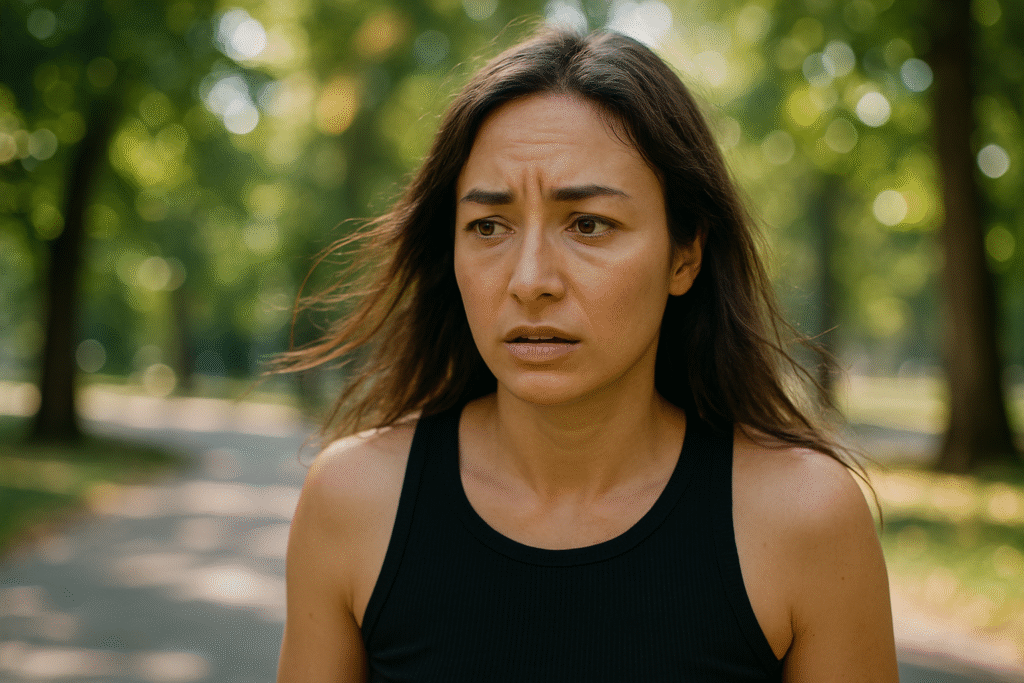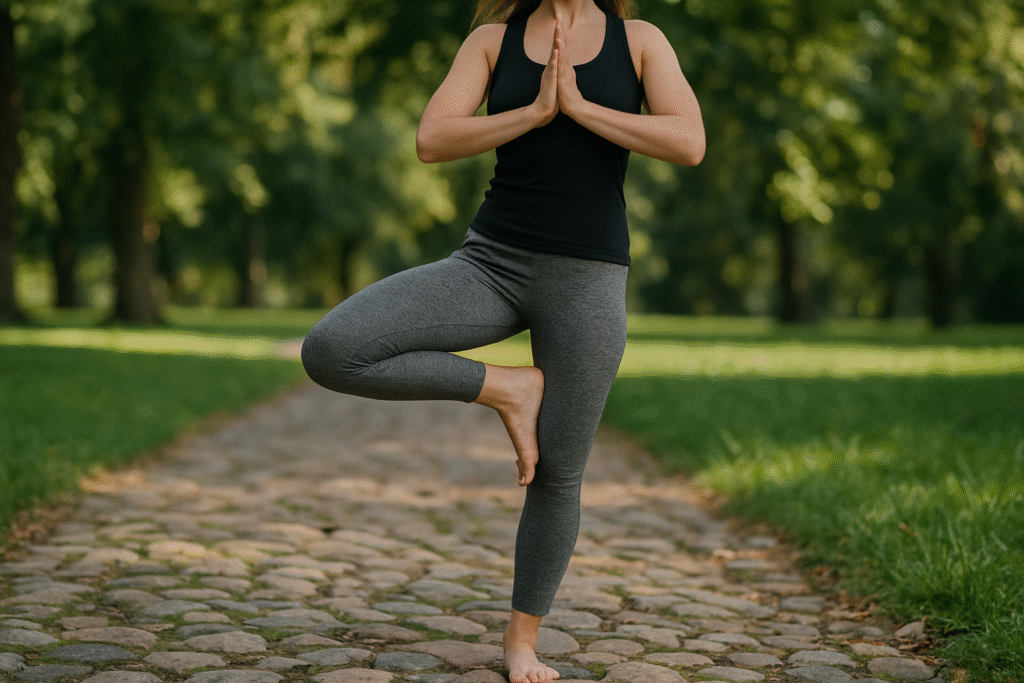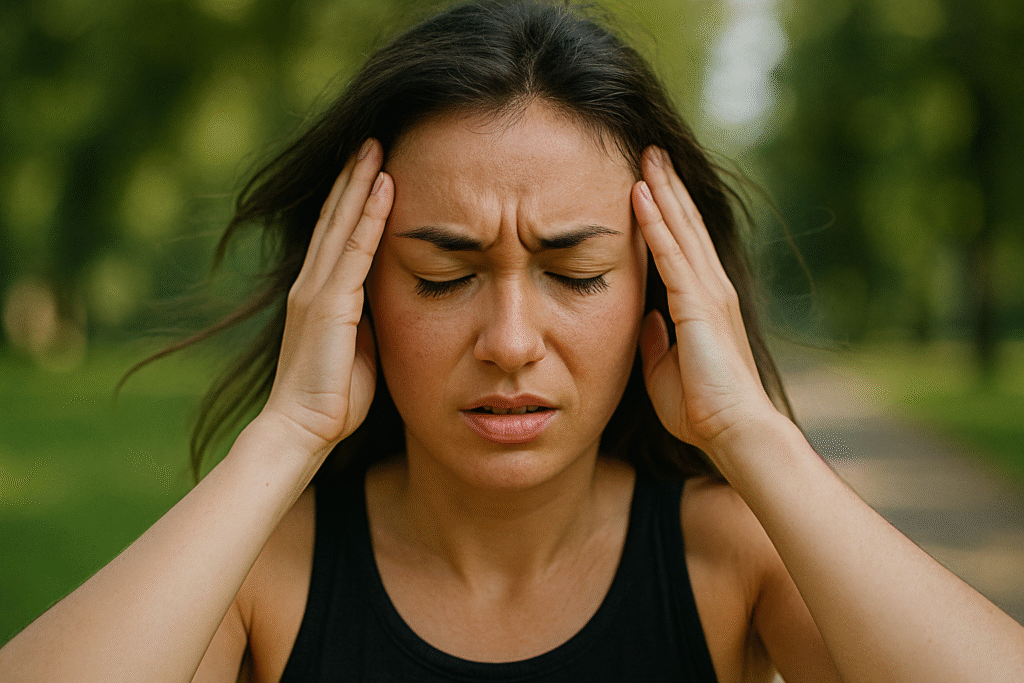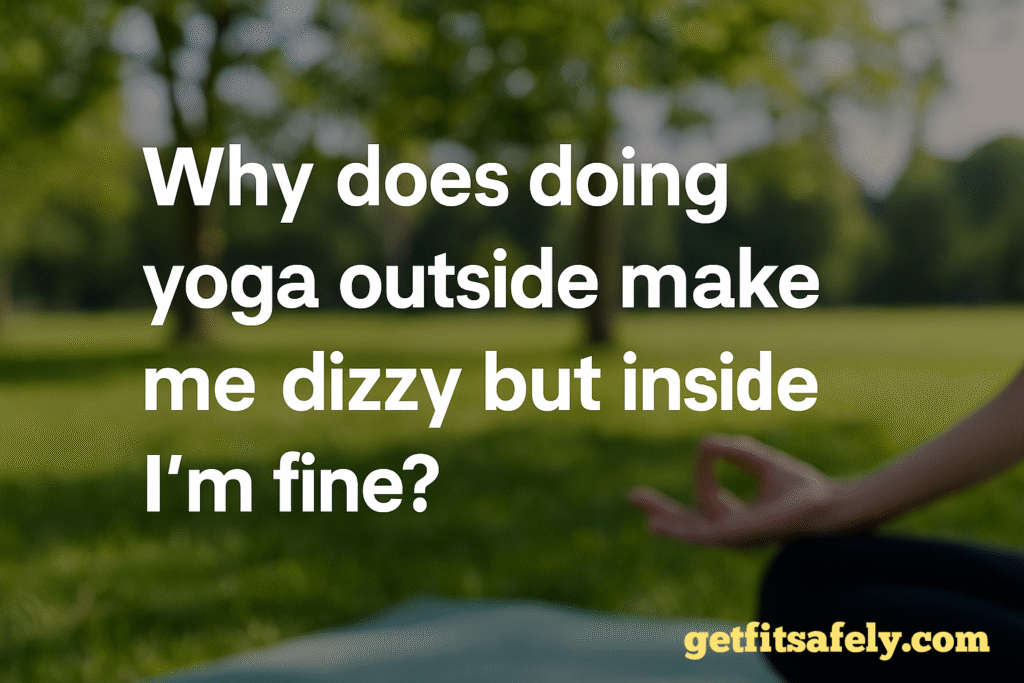Doing yoga outdoors has something poetic about it.
You breathe fresh air, listen to birds chirping, and feel part of nature.
Too bad that, for some, the ending of this idyllic scene is… a not-so-zen wave of dizziness.
Sounds strange?
You’re not alone.
Many people say they feel lightheaded, disoriented, or even slightly nauseous after an outdoor yoga session, while inside four walls this never happens.
But why does it happen?
And more importantly, how can you avoid turning your sun salutation into a salute… to the park bench, sitting and waiting for your head to stop spinning?
The role of light and peripheral vision

Outdoors, natural light isn’t uniform.
You might move from shadow to bright sunlight, and your eyes have to keep adjusting.
This constant visual “zoom” can trick your brain and make it work harder to figure out where you are in space.
On top of that, visual stimuli multiply: people walking by, leaves moving, light reflections.
Every tiny detail is an input for the vestibular system, the one that controls balance and orientation.
Too many signals?
The result: a feeling of instability.
Wind and temperature as hidden factors
Outside, the temperature doesn’t stay constant.
A gust of wind, a warmer ray of sunlight, a sudden chill.
Each little change alters your body’s perception, like your internal thermostat has to keep making “emergency adjustments.”
Wind isn’t just air brushing against you—it can influence your breathing.
If you inhale air that’s too cold or too hot, your diaphragm and respiratory muscles have to work harder, almost like doing mini workouts between one asana and the next.
This can create a slight feeling of breathlessness or instability, especially if your breathing rhythm gets interrupted.
Plus, wind can also “play” with your balance.
A sudden push from one side while you’re in a balance pose—like tree pose or warrior III—and your body must instantly activate all stabilizing muscles to keep you from looking like a mannequin falling in slow motion.
If this extra effort lasts, it can contribute to that lightheaded feeling.
The ground under your feet

Your home or studio floor is flat, stable, and reassuring.
Outside, you might be on grass, sand, dirt, or uneven cobblestone.
This forces stabilizing muscles—ankles, feet, calves—to work harder, constantly making micro-adjustments to your posture.
If those muscles are already tired or undertrained, your brain receives mixed signals: “Am I balanced? Or am I falling?”
This sensory confusion can easily turn into that “losing stability” feeling, and as a result, dizziness.
Different surfaces also transmit different vibrations to the body.
On sand, movements are slower and deeper.
On soft grass, you risk sinking a little.
On cobblestone, every weight shift can feel amplified.
All these micro-stresses add up and, especially in balance poses, can be the last straw… or rather, the drop that makes you wobble.
The concentration factor
In a yoga studio, the environment is quiet and protected.
Outside, you’re surrounded by random sounds: kids playing, dogs barking, honking horns, music, the neighbor mowing the lawn right during your final meditation.
Each sound is a little “hook” pulling you out of your practice and forcing you to bring your attention back to your body and breath.
This constant interruption can make you lose rhythm and even change the way you breathe or distribute your weight.
Visual stimuli also impact concentration: someone walking by, a bird flying overhead, leaves moving.
Each one competes for your attention and pulls you away from the mind-body connection yoga requires.
When your focus breaks too often, movements become more “mechanical” and less fluid, and your breathing can become irregular.
That mix of distraction, less stable posture, and altered breathing can open the door to instability or dizziness.
Why sometimes the body loses track of where it is—and you feel dizzy

Breath pause: the invisible culprit
You know that moment when, during the flow, you take a deep inhale and… boom: dizziness.
You’ve expelled CO₂ too quickly, changed your blood pH, and basically said “bye” to your neurons.
Breathe slowly, don’t hold your breath, and let your body do its thing instead of forcing influencer-yoga apnea.
The head rush (literally)
Ever done a backbend so intense you feel drained?
You might have bent your neck so far it’s blocking the arteries sending blood to your brain.
Small tweak: open your chest, lift your upper back, and keep your neck relaxed.
It works better and without the spins.
Rollercoaster-style dizziness: too-quick changes
Some folds or inversions can trigger that ride-like moment when everything spins.
Jumping from lying down or upside down to suddenly standing can throw you off.
Make the transition slow, like you’re coming out of a dream, and give your body time to say, “Okay, I’m here.”
Postural dizziness like orthostatic hypotension
From online discussions comes a valuable tip: if you stand up too quickly, blood pressure drops and your brain “rings the alarm.”
The trick: keep knees slightly bent, rise slowly, and if needed, do small bends to help blood flow back up.
When the inner ear labyrinth gets confused
The inner ear regulates balance and spatial awareness.
If you make fast movements or involve your neck too much, the internal fluid can disorient you.
When that happens, stop, close your eyes, breathe slowly, and let the system find its reference point again.
How to reduce the risk of dizziness
- Choose times when light is more stable, like early morning or late afternoon.
In these hours, the sun is less harsh, lighting changes more slowly, and your eyes don’t need to keep “refocusing.”
Plus, temperatures tend to be milder and more pleasant. - Stay well-hydrated before practice.
Dehydration can amplify lightheadedness because blood becomes “thicker” and circulates less efficiently.
Sip water slowly in the hour before class, avoiding an overly full stomach. - Avoid heavy meals right before starting.
When your stomach is busy digesting, part of your blood flow goes there, leaving fewer resources for muscles and brain.
Opt for a light, easily digestible snack if you need energy. - Choose more stable surfaces when possible, like a mat on flat pavement.
Even outdoors, you can find smooth concrete, a wooden deck, or even a terrace.
The more uniform the ground, the less extra work stabilizing muscles must do. - If the class is outside, position yourself in a spot less exposed to wind and direct sun.
A corner sheltered by a wall, hedge, or group of trees can make a big difference.
It reduces sudden gusts, glare, and temperature shifts that often trigger dizziness.
RELATED:》》》 Why do backbends in yoga give me a weird headache behind my eyes?
Conclusion: adapting yoga to the context
Doing yoga outdoors can be beautiful, but it’s not mandatory to reap the benefits of practice.
If you notice dizziness happens often, try adjusting a few variables: location, time of day, surface, intensity.
Yoga isn’t just about “doing the right poses,” but also about creating an environment where your body can work at its best.
Whether between four walls or under the sky, the goal stays the same: finding balance, inside and out.
FAQs
Why do I feel dizzy after certain yoga poses?
It might be orthostatic hypotension.
When you stand up too quickly from a bent or lying position, blood pressure can drop suddenly and your brain gets less oxygen for a few seconds.
To prevent it, rise gradually: bend your knees slightly, move slowly, and give your body time to stabilize blood flow.
What does the inner ear have to do with yoga dizziness?
The inner ear works like a tiny body GPS, using fluid-filled canals to regulate balance and spatial perception.
If you change position too quickly or move your neck a lot, the internal fluid can shift abruptly, sending mixed signals to the brain.
The result feels like being on a swaying boat.
In these cases, stop, close your eyes, and breathe slowly until the feeling passes.
Can allergies cause dizziness during outdoor yoga?
Yes, especially in spring and summer.
Pollen or dust can irritate the airways and the Eustachian tubes (which connect the inner ear to the throat), temporarily affecting balance.
Also, slight nasal congestion can reduce oxygen intake and make you feel lightheaded.
If you know you’re sensitive, choose days with low pollen counts or practice in more sheltered spots, like a courtyard or terrace.





